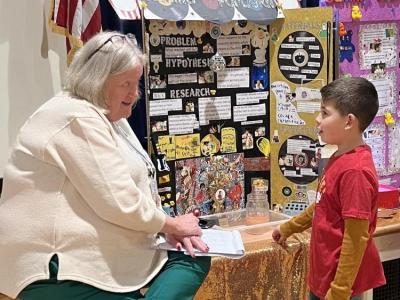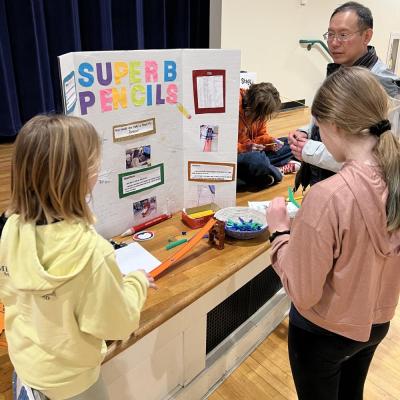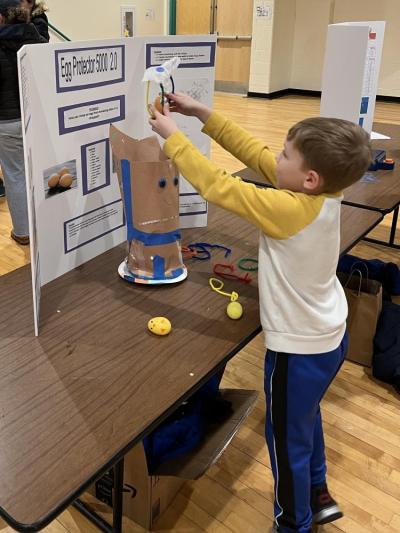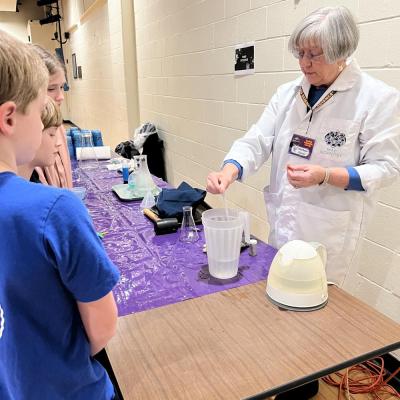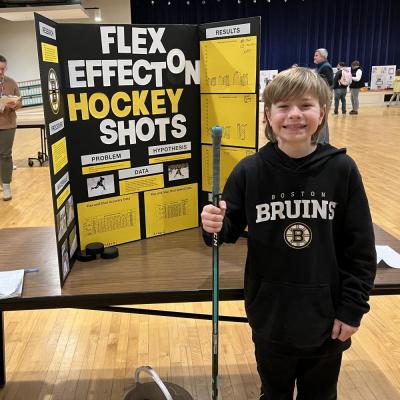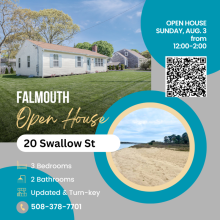Science fair at Sippican Elementary fosters creativity, learning
MARION – How do buildings stay standing during earthquakes? What makes a bridge safe? What type of wings would make a pencil fly the farthest when attached? Those were just some of the questions students looked to answer with projects presented during the Jan. 10 science fair at Sippican Elementary School.
Projects ranged from a venture into creating magnetic putty to a contraption that cools pillows to an investigation into which brand of gum has the longest-lasting flavor.
Altogether, 31 students between kindergarten and fifth grade created 20 different projects for the fair, according to enrichment teacher Chelsey Lawrence, who organized the event.
“I like their creativity and seeing what they choose to study and what they come up with,” Lawrence said. “It’s always very intriguing to see what comes in.”
Fifth-grader Kyle Vergoni examined how the flexibility of hockey sticks affects the speed and accuracy of a slapshot.
“I came up with the idea because I love the sport of hockey and I thought it’d be really fun to do it with a couple of my buddies,” Vergoni, 11, said. “I thought it would be a great project.”
Nearby, fellow fifth-grader Gia Goodwin presented her research into why her dog Finn foamed at the mouth after attempting to eat a frog.
The answer discovered by Goodwin? That frog had been a Fowler’s toad, which are native to Massachusetts and can release a poisonous bufotoxin from bumps on their backs.
“Marion in general, Massachusetts needs to make sure that they keep their dogs from eating this type of frog because it can be fatal,” Goodwin, 11, said.
Participation in the fair was voluntary and optional for Sippican students.
“It allows kids who want to, to spend the extra time to learn something new about science and to share what they’ve learned with their peers in our community,” Lawrence said.
Projects were completed at home, like that of Gina Hermenegildo, whose kitchen became a temporary laboratory for popcorn explosions and gummy bear osmosis conducted by second-grader Preston and first-grader Sophia.
Hermenegildo said the two worked all last weekend and had been looking forward to the event for weeks. She said the process taught Preston, 8, to ask more questions.
“‘What happens if we add this?’” Hermenegildo said. “‘What if we put a cover on it? What if we add more baking soda?’ Definitely makes him formulate more questions, which could have led to even more variables.”
For first-grader Daisy Almeida, participating in the science fair served as experience in creating and presenting a project, according to father Nathan Almeida. Daisy, 6, did experiments with bubbles, which were filmed.
“Our goal was to show her what it takes to do a presentation, attention to detail, especially the time and effort that needs to go into something to be able to get a good product out of it, and that’s not just a science lesson,” Almeida said. “That’s a life lesson.”
The projects at the science fair were also judged, split up by grades. Eliza Conley placed first in the grades K-2 group, and Charles Whinnem placed first for fifth-graders. Rowan Farquharson, Ana Pereira, Crosby Ribeiro and Emma Ayers placed first as a group in the grades 3-4 group.



